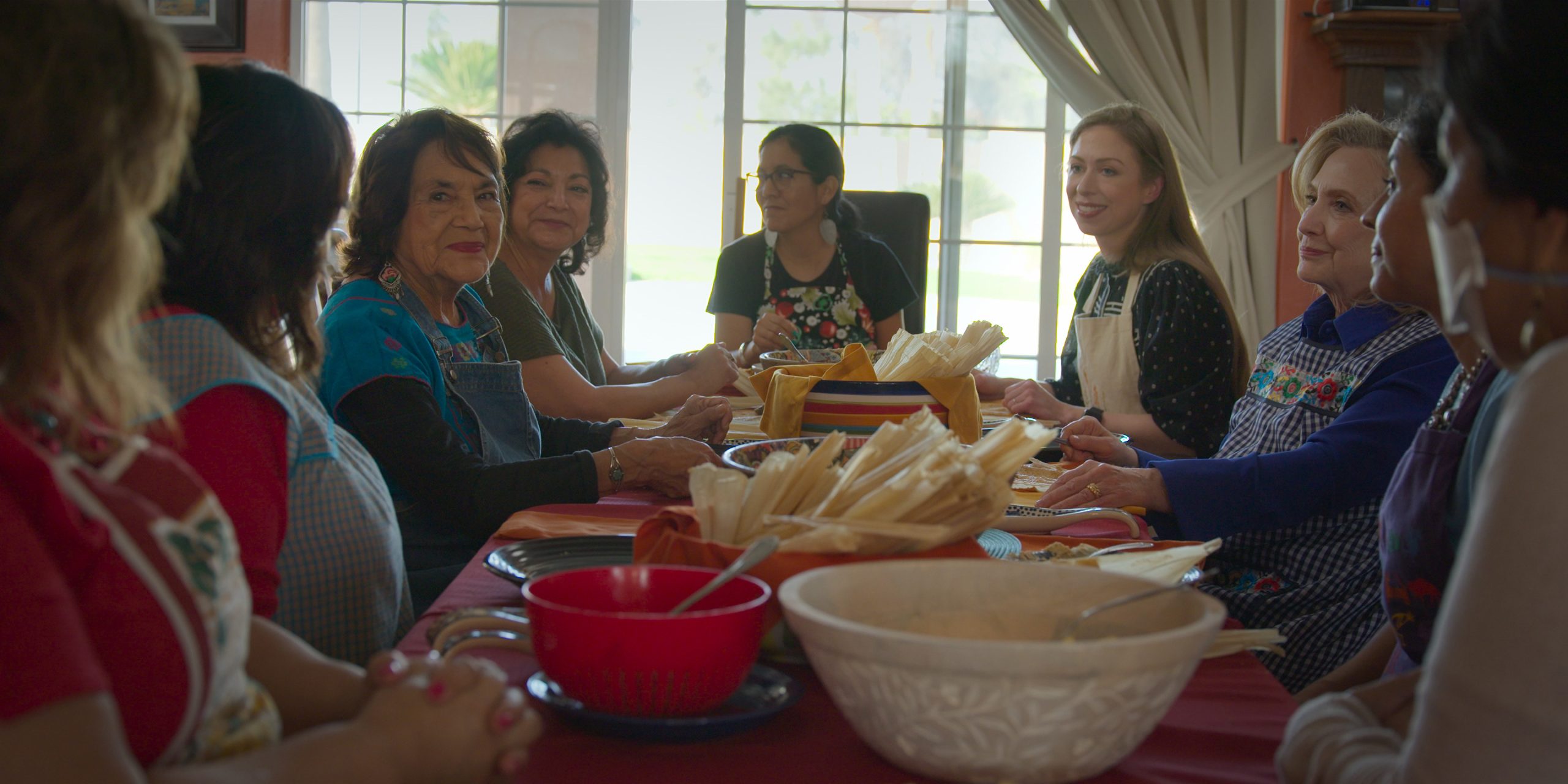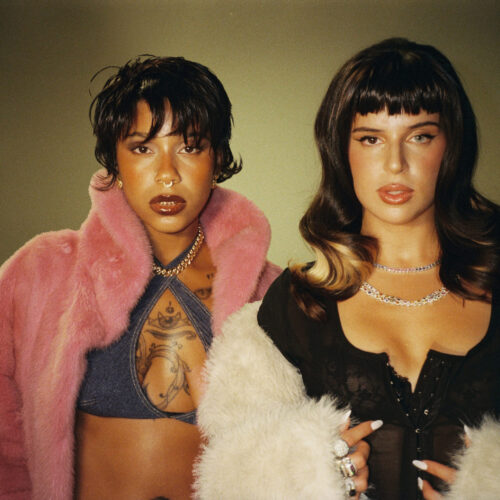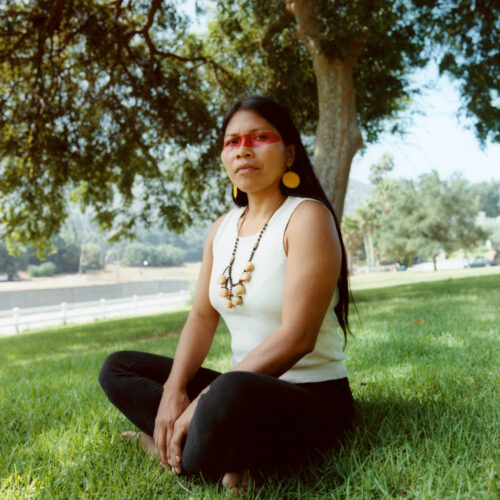To those familiar with the history of labor rights in the United States, Dolores Huerta needs no introduction. The legendary labor leader, famed for founding the United Farm Workers of America alongside Cesar Chavez in 1962 and coming up with the rallying cry “si se puede” (yes we can), had her work introduced to a wider audience by way of appearing in Gutsy, the new Apple TV+ docuseries based off of Hilary and Chelsea Clinton’s The Book of Gutsy Women. The series, showcasing impactful women in U.S. history, features interviews with Huerta and her daughters. Among other things, they discuss their work for the Dolores Huerta Foundation, which actively fights for communities of color in Central California.
Huerta began organizing long before starting her namesake foundation. In 1955, after quitting a job as a teacher and moving to Delano, California, she began to quietly organize what would become the now-famous Delano Grape Strike. Collaborating with Cesar Chavez, then a member of the Community Service Organization (still active today as Centro CSO), Huerta encouraged the farm workers in Delano to push for better working conditions, and after ten years of working person-to-person and building people power, the farm workers began the strike in 1965. Following the success of the strike, Chavez and Huerta would go on to organize action among thousands of agricultural workers, first through the Community Service Organization and then through various other organizations that would eventually coalesce as United Farm Workers.
Years later, the work continues with her own Foundation. As highlighted in Gutsy, it’s a family affair: her daughter Lori is heavily featured in the episode, alongside her youngest daughter Camila, who serves as the Executive Director of the Dolores Huerta Foundation. “[Camila] quit her job with a health fund in San Francisco, where she was getting a very good salary, to come and help me start the foundation for hardly any salary at all,” says Huerta in the episode. “We started out with a $100,000 grant from the Puffin Foundation and she grew us to a $6 million organization. I’m sure by growing up [surrounded by the farm workers] movement they all had gutsy moments that they had lived through; each one of my daughters has a gutsy story that they can tell,” Huerta told LATINA from her office in Bakersfield, California.
Today, the Dolores Huerta Foundation broadens its scope beyond farm workers’ rights. Based in Bakersfield, the organization has distributed COVID-19 vaccines to over 8,000 people, and has organized in over 200 schools in 17 different school districts. Huerta says that the key to reaching out to the families of these schools is through youth organizers.
“I think that organizing is a very special skill and that organizers can make the difference,” she says about the new generation. “I love to quote Cesar Chavez on this: he once told a younger college student joining the movement: ‘when you go to school, you can learn about history, you can study history, you can write about history, you can talk about history — but when you’re an activist, you can make history.’”
LATINA spoke to Huerta about her life of activism, the importance of the young Latino vote, and fighting back against racism within the Latino community.
This conversation has been edited and condensed for clarity.
Can you tell me about the energy in the days of the Delano Grape Strike and how you organized those workers?
Huerta: “I started as a volunteer organizer with the Community Service Organization in 1955. I was a volunteer for four years until I got a position with them as Political Director. Cesar [Chavez] and I left after they voted down an organizing project for farm workers, and that’s when we formed the National Farm Workers Association — we didn’t want the growers to know that we were organizing a union. We took three years to organize under the umbrella of the NFWA and then the strike broke out in 1965. We merged with this other organization, the Agriculture Workers Organizing Committee, and that’s when we became the United Farm Workers. And then we were out in the open. There was a lot of violence: people beaten up, threatened with rifles, pesticides sprayed on strikers, and five killed.”
After all of these years, do you feel like significant progress has been made?
We’ve made some advances. Some of the laws that we passed in both CSO and the United Farm Workers have benefited a lot of workers. We passed a law so people could get their driver’s license and ballots in Spanish and other languages, so you didn’t have to find a deputy registrar. We passed a number of laws to help immigrants get public assistance. We passed disability insurance for farmworkers. We passed agriculture labor relations laws so that farm workers could vote for a union because they were excluded from the National Labor Relations Act. We passed unemployment insurance for farmers. These went through the California State Legislature and then through Congress while we were lobbying in the 70s and 80s. Constituents put pressure through letter-writing, going to their offices, and emails. You have to put pressure on these people to pass laws.
How did you get constituents to listen to you?
By grassroots organizing — meeting with families and working in their homes. We do the same with my foundation right now. An example: a high school district expelled over 2000 students of color in one year. We met [individually] with the families of the students, in their homes, and then [eventually] we brought them together. We had over 150 parents, and [helped them to] file a lawsuit against the school district.
In the age of “Instagram Activism,” can you speak to the difference between on-the-ground organizing vs mobilizing via digital platforms?
When people mobilize, they’re already on the same page. They already know what the issue is, and come together to march or protest. Organizing is when you’re talking to people that don’t know how to solve the problem. They know there’s a problem there, but they don’t have any idea of how to solve it. That’s where person-to-person organizing becomes very important.
I know you’ve also been pushing for representation as far as Latino politicians and having us represented within caucuses…what has that process been like?
Our organization was able to get 84,000 people to sign up for the census in the Central Valley of California. We did redistricting with our own demographer in four different counties, which are bigger than some states. We did community surveys and presented them in community hearings. All of our maps were adopted by the independent commission, so now we have an additional assembly seat, an additional congressional seat, and a seat that represents the Latino community and communities of color like Black, Asian, Hindu, and Sikh.
Something that has really been on the mind of a lot of young Latino people is the anti-Black racism within our community and society’s reckoning with that since the summer of 2020. That’s recently come to the fore in California with LA Council Member Nuri Martinez’s racist comments. Can you speak to the importance of that racial reckoning within the Latino community when you lobby for representation?
I think what happened with all of those [politicians] is that power and greed blinded them. I consider their actions a betrayal of our community, of the Black community, the Indigenous community, the Asian community, and their constituents of color. They betrayed all of us by the statements. We all have to continue to fight against colorism and racism that exists in the Latino community. We have to keep reminding people where this comes from: slavery. Indigenous people were the first slaves. We have to remember that the reason that [white and white-passing Latinos] justify the slavery of all of us is because of our color. A lot of people don’t remember where they came from. If your skin is lighter, you have a better job opportunity because colourism and racism exist at every level of our society. Oftentimes, in our families, when a baby is born, we celebrate him porque esta bien guërito” [because he is so blonde], and I say we have to change that narrative and start also saying que bonita la niña porque está bien prieta” [that little girl’s dark skin is so beautiful]. We have to change that narrative within our own families.
A lot of people my age in organizing circles got into that work because they felt hopeless in voting. What would you say to those young organizers?
You have to vote. This is the foundation of our democracy. Once we elect somebody to office, we have to stay on top of them — the corporations and the lobbyists, we have to be in their offices every day. In 2023, with our California health care plan, people 50 years and above are going to [have health coverage] even if they’re undocumented. How did we do that? By electing good people to our state legislature! Electing a good governor, and then doing the lobbying that we needed to do to get it passed.
Another example I like to give is one of the things that we won for the farm workers were toilets! They didn’t have toilets in the fields. They didn’t have cold drinking water, and that’s one of the things that we won for them, and not only in our contracts. We passed the law — not only in California where the strike was, but all over the United States — they have to have toilets for the farm workers in the field. We had to put it into law to make it happen, that’s what young people have to understand. It’s important for us to vote. Find candidates you like and go out there and knock on doors. That was the beginning of my activism.
Something widely attributed to you is the popularization of the phrase “si se puede.” I was just thinking about the power of that phrase and how it has endured. What does it mean to you that it’s become a rallying call for the Latino community?
In Spanish, it not only means “yes we can,” but also “yes, I can.” It’s got a lot of power because of that reason. It’s singular and collective. We can make it happen, pero tenemos que estar [unidos] — we have to stand together. This is the way that we make things happen.
To follow support the Dolores Huerta Foundation, check out their website. You can stream episode 8 of Gutsy, featuring the Huertas, on Apple TV+.









